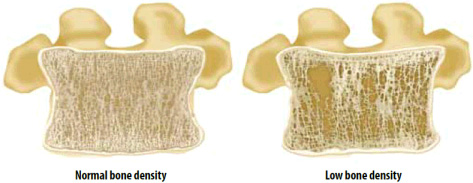
Osteoporosis is a condition in which our bones become weakened, increasing the risk of fracture, typically in the hip or spine. Our bones reach a maximum density when we are about 30 years old, and from that point, the density begins to decline. Fractures can result in loss of quality of life from the pain and decreased activity. Some individuals also suffer from depression as a result.
Roughly 10 million Americans have osteoporosis and about 34 million are at risk. It is especially prevalent in people over age 50. It is a silent condition–there are no symptoms that alert us to our bones losing density, until we have a fracture.
Osteoporosis not only increases the risk of large hip, spine or wrist fractures, even with a minor trauma such as bumping into furniture or slipping off the couch, but it may also cause shortened height due to repetitive small vertebral fractures.
How can you know if you’re at risk? Your healthcare provider can assess your risk by asking you questions about your health and lifestyle. Your gender and age significantly impact your risk, as does your history of smoking and alcohol use. Both smoking and alcohol use are linked to lower bone density. Your medication history, level of physical activity and your family history of fractures is also important information. And lastly, if you are a woman your menopausal status and overall reproductive history are also factors to consider.
Your healthcare provider may also recommend a bone density scan. Sometimes called a DXA examination (dual x-ray absorptiometry), this low-dose x-ray measures the bone density in your spine and left hip, and sometimes in your left wrist.
A FRAX (Fracture Risk Assessment Tool) score is calculated in individuals who 1) have low bone density (osteopenia), 2) are post-menopausal or over the age of 50, and 3) have never taken an osteoporosis medication. The FRAX tool was developed by the World Health Organization (WHO) to estimate how likely you are to suffer from hip and other fractures over the next 10 years.
What can you do to prevent osteoporosis? Maximizing your intake of calcium and vitamin D, as well as exercising go a long way towards prevention. Women over age 50 and men over age 70 should take at least 1200mg of calcium daily, either through diet alone or through over-the-counter supplements. Additionally, 800-1,000 IU of vitamin D should be taken daily by men and women over age 50.
What forms of exercise are best for lowering your risk? Weight bearing movements and muscle strengthening exercises are best. Weight bearing exercises include dancing, hiking, jogging, and stair climbing. Muscle strengthening can be achieved by lifting weights, or through no-impact balance and posture exercises (usually taught by a physical therapist).
Minimizing the amount of alcohol you drink and quitting smoking are also important in reducing your risk of osteoporosis.
If tests show your bone density is severely low, or if you have already suffered a fracture, your healthcare provider may recommend prescription medications including bisphosphonates (Fosamax, Boniva, Actonel, etc.), Selective Estrogen Receptor Modulators (SERMs), (Raloxifene), estrogen, or calcitonin.
If you are over the age of 50 and have not yet had an osteoporosis risk assessment, talk to your healthcare provider.
The Breast Center at Valley Medical Center conducts bone density scans. For more information call 425-656-5588 or visit valleymed.org/breastcenter.

